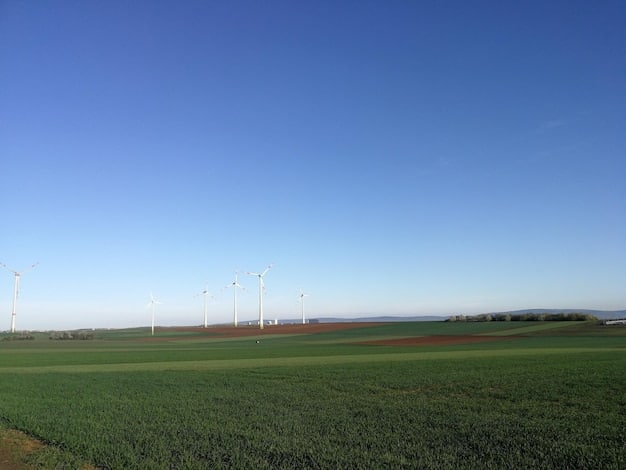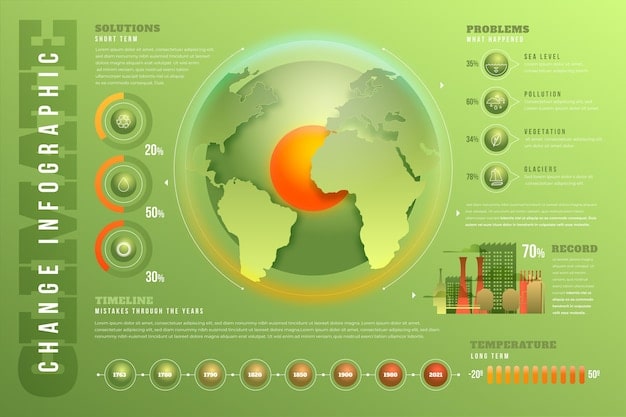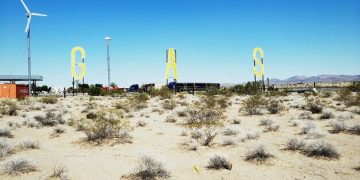US Energy Evolution: Meeting Climate Targets in the Next 25 Years

Over the next 25 years, the US energy mix will likely shift towards renewable sources like solar and wind, coupled with advancements in energy storage and grid modernization, to meet ambitious climate targets and reduce carbon emissions.
The United States is at a crossroads in its energy policy, striving to balance economic growth with ambitious climate goals. How will the US energy mix evolve over the next 25 years to meet climate targets? Let’s delve into the potential pathways.
The Current US Energy Landscape
To understand the future, we must first examine the present. The US energy landscape is a complex tapestry of fossil fuels, nuclear power, and renewable energy sources. Fossil fuels, including coal, natural gas, and petroleum, have historically dominated the energy mix.
Fossil Fuels: A Lingering Giant
Despite the growing emphasis on renewables, fossil fuels still play a significant role in meeting US energy demands. Natural gas, in particular, has seen increased use due to its lower carbon footprint compared to coal.
The Rise of Renewables
Renewable energy sources, such as solar, wind, hydro, and geothermal, are rapidly gaining traction. Technological advancements and decreasing costs have made them increasingly competitive.
- Solar energy capacity has expanded dramatically, driven by federal and state incentives.
- Wind power is now a cost-effective option in many regions, contributing significantly to electricity generation.
- Hydropower remains a reliable source of renewable energy, although its growth potential is limited by environmental concerns.
In conclusion, the US energy landscape is currently a mix of traditional fossil fuels and rapidly growing renewable energy sources. The future energy mix will depend on factors like policy changes, technological advancements, and economic considerations.
Policy Drivers and Climate Targets
Government policies and international agreements are pivotal in shaping the future US energy mix. Ambitious climate targets, such as those outlined in the Paris Agreement, necessitate a significant reduction in greenhouse gas emissions.
Federal Regulations and Incentives
Federal policies, including tax credits and renewable energy standards, incentivize the deployment of renewable energy technologies. These policies play a crucial role in accelerating the transition towards a cleaner energy mix.
State-Level Initiatives
Many states have implemented their own renewable energy targets and carbon reduction goals, often exceeding federal standards. California, for example, has set a goal of 100% clean energy by 2045.

The interplay between federal and state policies creates a dynamic environment for energy innovation and deployment. These policy drivers are essential for achieving long-term climate targets.
The Projected Growth of Renewable Energy
Looking ahead, renewable energy is projected to experience substantial growth in the US. Solar and wind power are expected to lead this expansion, driven by their decreasing costs and increasing efficiency.
Solar Energy: A Bright Future
Solar energy, both photovoltaic (PV) and concentrated solar power (CSP), is poised for significant growth. Advancements in solar panel technology and energy storage solutions will further enhance its viability.
Wind Power: Harnessing the Breeze
Wind power is another key player in the future energy mix. Technological improvements in turbine design and offshore wind development offer considerable potential for increased electricity generation.
The growth of renewable energy hinges on overcoming challenges related to intermittency and grid integration. However, with continued innovation and policy support, renewables are set to dominate the US energy mix in the coming decades.
Technological Advancements in Energy Storage
Energy storage is crucial for addressing the intermittency challenges associated with renewable energy sources. Advances in battery technology, pumped hydro storage, and other storage solutions are transforming the energy landscape.
Battery Technology: Powering the Future
Lithium-ion batteries have emerged as the dominant energy storage technology. Ongoing research and development efforts are focused on improving battery performance, reducing costs, and enhancing safety.
Pumped Hydro Storage: A Proven Solution
Pumped hydro storage, a well-established technology, offers large-scale energy storage capabilities. It involves pumping water uphill to a reservoir and releasing it to generate electricity when needed.
- Thermal energy storage and compressed air energy storage are also gaining attention as potential solutions.
- These storage technologies can help balance the grid, ensuring a reliable supply of electricity even when renewable energy sources are not generating power.
In short, technological advancements in energy storage are critical for enabling the widespread adoption of renewable energy and ensuring a stable and reliable energy supply.
Grid Modernization and Infrastructure
A modern and resilient electricity grid is essential for integrating renewable energy sources and ensuring a reliable power supply. Grid modernization efforts include investments in smart grid technologies, transmission infrastructure, and cybersecurity measures.
Smart Grid Technologies
Smart grid technologies, such as advanced metering infrastructure (AMI) and grid automation systems, enable real-time monitoring and control of the electricity grid. These technologies enhance grid efficiency and reliability.
Transmission Infrastructure
Upgrading and expanding transmission infrastructure is crucial for transporting electricity from renewable energy generation sites to population centers. Investments in high-voltage transmission lines are needed to accommodate the growing share of renewable energy.

By modernizing the grid and investing in infrastructure, the US can unlock the full potential of renewable energy and ensure a reliable and secure electricity supply.
Economic and Social Implications
The transition to a cleaner energy mix has significant economic and social implications. Investments in renewable energy create new jobs, stimulate economic growth, and reduce dependence on fossil fuels. However, this transition also presents challenges for communities reliant on fossil fuel industries.
Job Creation and Economic Growth
The renewable energy sector is a significant source of job creation. Solar and wind energy industries employ hundreds of thousands of people in the US, and this number is expected to grow in the coming years.
Addressing Social Equity
It’s important to ensure that the transition to a cleaner energy mix benefits all communities, including those historically disadvantaged by the energy system. Policies should address issues of energy affordability, access to clean energy, and workforce development.
The economic and social implications of the energy transition are multifaceted and require careful consideration. By prioritizing job creation, economic growth, and social equity, the US can ensure a sustainable and inclusive energy future.
| Key Point | Brief Description |
|---|---|
| ☀️ Renewable Growth | Solar and wind power are set for significant growth in the US, driven by decreasing costs. |
| 🔋 Energy Storage | Advances in battery technology are crucial for addressing the intermittency of renewables. |
| ⚡ Grid Modernization | Upgrading the grid is essential for integrating renewable energy and ensuring a reliable power supply. |
| 💼 Job Creation | The renewable energy sector is creating new jobs and stimulating economic growth in the US. |
FAQ
▼
The main drivers include federal and state policies, technological advancements in renewable energy and storage, and economic considerations such as decreasing costs of solar and wind power.
▼
The US is promoting the use of renewable energy sources through incentives, regulations, and investments in renewable energy infrastructure and grid modernization efforts to reduce fossil fuel usage.
▼
Energy storage is critical for integrating intermittent renewable sources like solar and wind. Advances in battery technology and pumped hydro storage can balance the grid effectively.
▼
Transitioning to renewable energy can create new jobs in the renewable energy sector, stimulate economic growth, and reduce the economy’s dependence on the volatile prices of fossil fuels.
▼
Many states have set ambitious renewable energy and carbon reduction goals that often exceed federal standards, driving innovation and accelerating the adoption of cleaner energy sources within their regions.
Conclusion
In conclusion, the US energy mix is poised for a significant transformation over the next 25 years, driven by policy, technology, and economics. The shift towards renewable energy sources, coupled with advancements in energy storage and grid modernization, offers a path towards a sustainable and resilient energy future.





